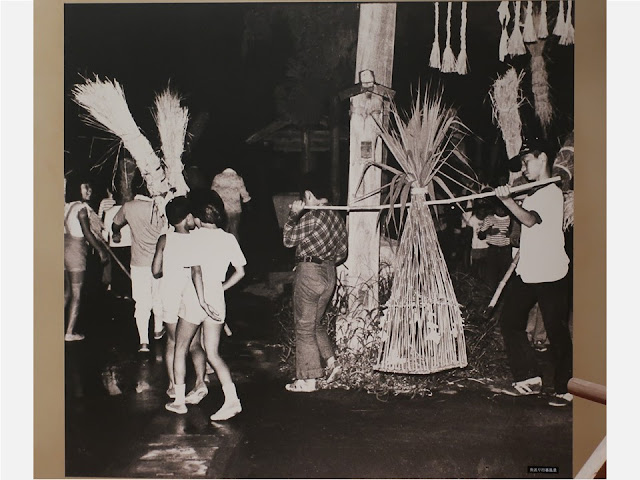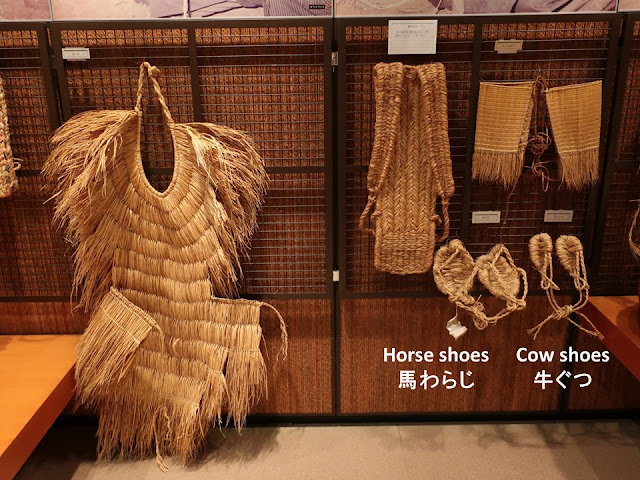Nagano is located at the central Japan and it is an inland prefecture. The museum was built at the old battlefield. Takeda Shingen and Uesugi Kenshin fought in the 16th century.
The exhibits about local lives and livelihoods are great and those about the history are also excellent. I'll introduce exhibits of the history in the next article (part2). Btw, Zenkouji Temple and the silkworm-raising industry are integral parts of exhibitions of Nagano.
上杉謙信と武田信玄が戦った川中島の古戦場後に博物館があります。歴史展示(Part2で紹介)もさることながら、稲作など人びとの生業・暮らしの展示が分かりやすいです。養蚕と善光寺は欠かせません。
Farmers’ livelihood、農家の暮らし
It’s a very understandable section which starts with “A year of rice farming” before the mechanization.
「米づくりの一年」からはじまる機械化前の農家の暮らしの展示が、とても分かりやすいです。
The rice farming begins with ploughing in March and ends with removing chaff from paddy in November.
米づくりは、3月の田起からスタートし、11月の臼挽きまで続きます。
Typical female farmer wore a straw hat, a covering for the back of the hand and wrist (tekkou), women's loose work trousers (monpe) and so on. Manual farming equipment are also exhibited.
In tilling season, some farmers who lived in mountainous areas came to Nagano together with horse in order to work in Nagano city. Because it was too cool to till in their areas. They usually owned horses to carry things in hill roads; the horses were very useful workforce for ploughing. It’s a good practice and it probably enhanced the exchange among them.
編み笠、手甲、もんぺが農婦の作業着でした。鍬などの耕作道具も置かれています。
代掻きの時期には、山間の西山地域から馬を連れて出稼ぎに来る人々がいました。山間部では、坂道での運搬などのために馬を飼っている人が多く、また、代掻きの時期が遅いためちょうど良かったそうです。盆地と山間部の良い交流になりますね。
Seeds were put in the bag and soaked in a pond or a stream for around twenty days after Spring Equinox Day.
種浸しの麻袋。種籾を入れ、お彼岸頃から20日間ほど、池や小川に浸します。
Pre-planting preparations. Manual tilling was so hard that a horse was very helpful.
代掻き。人力では大変です。馬力はありがたいはずですね。
Buckets for carrying fertilizer
肥料を運んだ肥桶。天秤棒を担いで運びました。
The tools for weeding were used after planting.
田植が終わって、稲が育ちはじめると雑草取りです。
Traditional insect control event in summer is called “Mushi (insects) Oi (driving away)”. Children carry straw objects and parade to the village border with hitting drams and gongs. Insects are expected to escape from their village.
害虫を追い出す行事、虫追い。鉦や太鼓で囃子ながら、藁人形などを村境まで送ります。子どもが多いですね。夏の行事です。
Reaping, threshing, and rice husking; it is a rewarding and happy season.
稲穂が実ると収穫。嬉しいシーズンですね。
Various uses for rice straw、藁の利用
Rice straw had been the most useful material before plastic spread. It is soft and elastic, so it is easy to handle for production. We made various everyday items using straw since rice farming technology came to Japan. Straw is material of ritual equipment such as shimenawa rope in shrine even until now.
柔らかで弾力性があって加工しやすい藁を利用して様々な生活用具を作ることは、弥生時代から続いた重要な作業でした。プラスティックが普及するまで人々の生活を潤してきました。また、しめ縄など行事の用具としては、今も使われています。
Mino raincoat, horse shoes, cow shoes and many other things were made of straw.
簑、背負子を背負うときのクッション(背中当て)、だけでなく、馬わらじ、牛ぐつも作りました。
The big face is made from the New Year straw decorations which are gathered from villagers on the 7th of January. It is placed in front of the dosojin (god) at the village border. It says, “Is this a god face who protect the village from demons?” Sake (alcohol) container, cups and tai fish, which are also made from straw, are offered to the face. It is a custom of Ohoka village in mountainous area.
山あいの大岡村では、1月7日に松飾りをおろして、村はずれの道祖神の前に持ち寄り、しめ縄でこの顔を作ります。「悪霊から村を守ってくれる神様の顔なのでしょうか」と書かれています。酒樽、盃、鯛も藁で作られて供えられます。
Village spiritualism、村人の祈り
There used to be various prayers before science developed. Straw was used in those rites.
ここでも藁が登場します。科学が進んでいなかった時代、いろいろな祈りの行事が行われました。
In “Donto yaki (burning)” event, the New Year decorations are burned; it is well-known across Japan. Children try to grill something (maybe foods such as mochi cake).
松飾りを燃やすどんと焼は、広く全国で見られます。子どもたちが竿で何か(たぶん餅、今はマシュマロも)を吊して焼こうとしています。
Nagano has been a horse breeding area since the ancient era. In Kirihara, people pray for good horse production and offer the straw horses to the shrine.
長野は古代から馬の生産地です。桐原の牧では、今も、良馬産出を祈願して供えられる馬の人形が桐原神社に奉納されています。くじ引きが行われ、当りくじの人は写真にあるような小さな藁馬をいただけます(2024年3月追記)。
There is a rebuilt farmhouse and “Life of farmers and straw work” is explained in it. It says, “Grandpa made straw items all year long.”
It is also written about holidays and rest days in the early 20th century. Those were not decided by the government; it had been custom since the Edo period (1603~1868). There were eleven holidays except for the national holidays.
New Year’s greetings: 9th and 10th of February,
Visitor’s day: 38th of March, Oyouka festival: 8th of
May, Rest days after rice planting: 10th of July, Ten-noh-age festival:
7th of August, Festival of silkworm god: 1st, 2nd
and 3rd of October, Silkworm festival: 11th of October, Sports
Day: 22nd of October. There were many holidays after harvest season.
Reference: Village holidays in the Edo period
復元された農家の中に、「農家の一年と藁仕事」というパネルがあります。「おじいさんは一年中藁仕事を行っていました」と書かれています。
昭和初期の「あそび日」が書かれています。学校はカレンダーで動いていましたが、農家には「あそび日」がありました。江戸時代の名残ですね。2/9-10(年始会)、3/28(来客)、5/8(オヨウカ/祭り)、7/10(田植え後の農休)、8/7(天王上げ)、10/1-3(神社・蚕神様の祭り)、10/11(蚕祭り)、10/22(運動会)でした。合計11日、収穫後の10月に多いですね。
参考(江戸時代の遊び日):村の遊び日
Sericulture、養蚕
It was the integral part of livelihood in Nagano. Ema (wooden board offering to the shrine) and old manufacturing equipment are exhibited.
長野の欠かせない生業ですね。大きな絵馬と道具が展示されています。
On the Ema board, a cat is depicted. It is a useful animal, because mice eat silkworm cocoons.
絵馬には、蚕に餌をあげている女性の横に猫が描かれています。ネズミが繭を食べてしまうので、猫は重宝がられたそうです。
Producing apples and soba (buckwheat) are important industries of Nagano now.
今の長野は、蕎麦とりんご。
Salmons used to go up Chikuma River. Thank-you letter from the famous lord (daimyo, Maeda Toshitsune) in the 17th century is exhibited; he got a salmon as a gift from Nagano. Although the dams stop salmons now, people are making effort to return salmons to Nagano such as building fish paths beside dams.
かつて、千曲川に鮭が来ていました。長野市(丹波島宿本陣)から加賀藩主・前田利常に初鮭を送ったときの礼状(複製)も展示されていました。ダムに鮭が遡上できる魚道をつけるなど改良をして、鮭や鱒を呼び戻す努力が続けられています。
Changes of children’s games、遊びの移り変わり
It is written, “Although the games changed with the times, boys had played outdoor games in which they learned the group rules; girls learned the rules of life or learned handwork through playing.” I agree.
「遊びは時代とともに変わっても、男の子は戸外で集団のきまりを覚えるような遊びを、また女の子は家の中などで、生活のきまりや手先の仕事を覚えるような遊びをしてきました」と書かれています。確かにそうでした。
Bamboo skis, ski poles and a wooden sled are exhibited. Nagano is a snowy region; Winter Olympic Games were held in 1998.
竹スキーとそり。雪国らしい展示です。
Japanese traditional wooden shoes (geta) are attached to ice skate blades. It was my first time to see them in person.
下駄スケート、初めて実物を見ました。
Many everyday goods are exhibited. It is a winter comforter “Kaimaki”. People wore it in order to prevent cold air coming inside the bedding; it was used until around 80 years ago. Buckwheat chaff is in it, because it is near at hands; cotton was packed in a luxury comforter.
民具の展示も豊富です。夜着、かい巻ともいう冬の布団です。冬の寒さが厳しい長野では、これを着て、肩からの冷たい空気を防ぎます。80年ほど前まで、使っていたそうです。これは、そば殻入りで、綿が入った物は贅沢品でした。
Visited in July, 2021
Official website: https://www.city.nagano.nagano.jp/museum/
(in Japanese), accessed in March, 2022
Previous post (Prefectural museum of Nagano): Nagano
Prefectural Museum of History、長野県立歴史館
Next post (History of Nagano city): Nagano City Museum(2/2)、長野市立博物館(2/2)



























Comments
Post a Comment